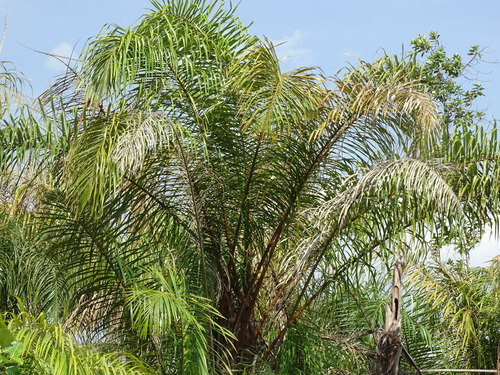Raphia hookeri

|
|
Raphia hookeri Common Names: Raffia Palm, Ivory Coast Raffia Palm,
Wine Palm Scientific
Classification Kingdom: Plantae Phylum: Tracheophyta Class: Liliopsida Order: Arecales Family: Arecaceae Genus: Raphia Species: R. hookeri Binomial Name: Raphia hookeri G.Mann & H.Wendl. Morphological Description Raphia hookeri is
a tall, monocarpic palm, reaching 10–15 m in height, with a solitary or rarely
clustered stem. Its key features include: · Stem: Robust, 10–15 cm in diameter, covered with fibrous leaf
sheaths · Leaves: Pinnate, massive, 10–15 m long, with 160–180 leaflets per
side; leaflets up to 3.5 m long (subsp. gigantea) and 5 cm wide · Inflorescence: Pendant, up to 3.5 m long, produced terminally before the
palm dies · Fruit: Ellipsoid to turbinate, 5–12 cm long, 4–6 cm wide, covered
in yellow-brown scales, enclosing a hard seed The palm’s fibrous
hypodermis and vascular system enhance its resilience in swampy habitats (Oboh
et al., 2017). Distribution and Habitat Raphia hookeri is
native to West and Central Africa, from Senegal and Sierra Leone eastward to
the Central African Republic and DR Congo, and south to Angola. It thrives in: · Ecosystems: Lowland freshwater swamps, riverbanks, and coastal wetlands
(0–500 m altitude) · Soils: Light-textured, acidic (pH 4.5–6.0), often waterlogged up to
1 m deep · Climate: Tropical, humid (rainfall 1,500–3,000 mm annually),
temperatures 25–30°C It is cultivated in
Nigeria and occasionally in India and Southeast Asia (Fern, 2024). Ethnopharmacology Raphia hookeri,
commonly known as the raffia palm, is a versatile plant native to West and
Central Africa, extensively utilized in traditional medicine for various
therapeutic purposes. The oily mesocarp of its fruit is traditionally applied
as a laxative, stomachic, and liniment for alleviating pain. Scientific studies
have demonstrated that aqueous extracts from Raphia hookeri leaves exhibit
antioxidant properties and inhibit carbohydrate-hydrolyzing enzymes, suggesting
potential benefits in managing type 2 diabetes mellitus by reducing blood
glucose levels and mitigating oxidative stress in pancreatic cells.
Additionally, research indicates that the mesocarp of Raphia hookeri fruit
possesses antioxidant and neuroprotective activities, offering protection
against aluminum chloride-induced neurotoxicity in rats. Furthermore, the pulp
and seed of Raphia hookeri are considered non-toxic and rich in vitamins and
phytochemicals, supporting their use as both food and medicinal resources. · Antidiabetic: In Nigeria, palm wine treats diabetes; it reduced blood
glucose by 53.57% at 300 mg/kg in T2D rats, enhancing insulin secretion
(Erukainure et al., 2019). · Laxative: In Gabon, boiled fruit mesocarp treats constipation;
flavonoids and saponins identified as active compounds (Oboh et al., 2017). · Antioxidant: Leaf extracts inhibited α-amylase (IC₅₀ = 110.4 µg/mL) and
α-glucosidase (IC₅₀ = 99.96 µg/mL), reducing oxidative stress in T2D rat
pancreas (Dada et al., 2017). · Aphrodisiac: In Cameroon, palm wine boosts libido; it mitigated
testicular oxidative damage in diabetic rats (Erukainure et al., 2021). · Febrifuge: Root decoctions in Sierra Leone reduce fever;
anti-inflammatory effects noted (Burkill, 1985). ⚠ Toxicity Profile: Raw fruit mesocarp is toxic due to cyanogenic
glycosides and saponins, requiring boiling to detoxify. Palm wine’s LD₅₀
exceeds 5,000 mg/kg in rats, but high doses may cause mild liver stress
(Erukainure et al., 2019). Additional Uses · Palm Wine: Sap yields 1,500–2,000 L per tree over 3–7 years, with
ethanol rising from 2% to 5% in 8 days (NIFOR, 2022). · Fiber: Leaf fibers used for mats, ropes, and baskets; stem fibers
for paper pulp (Mogue Kamga et al., 2020). · Nutritional: Boiled fruit pulp rich in vitamin E (2.8 mg/100g) and niacin
(1.2 mg/100g) (Ogbuagu, 2008). References
External Links More Pictures |
|
| Compounds of Raphia hookeri | |
| References |